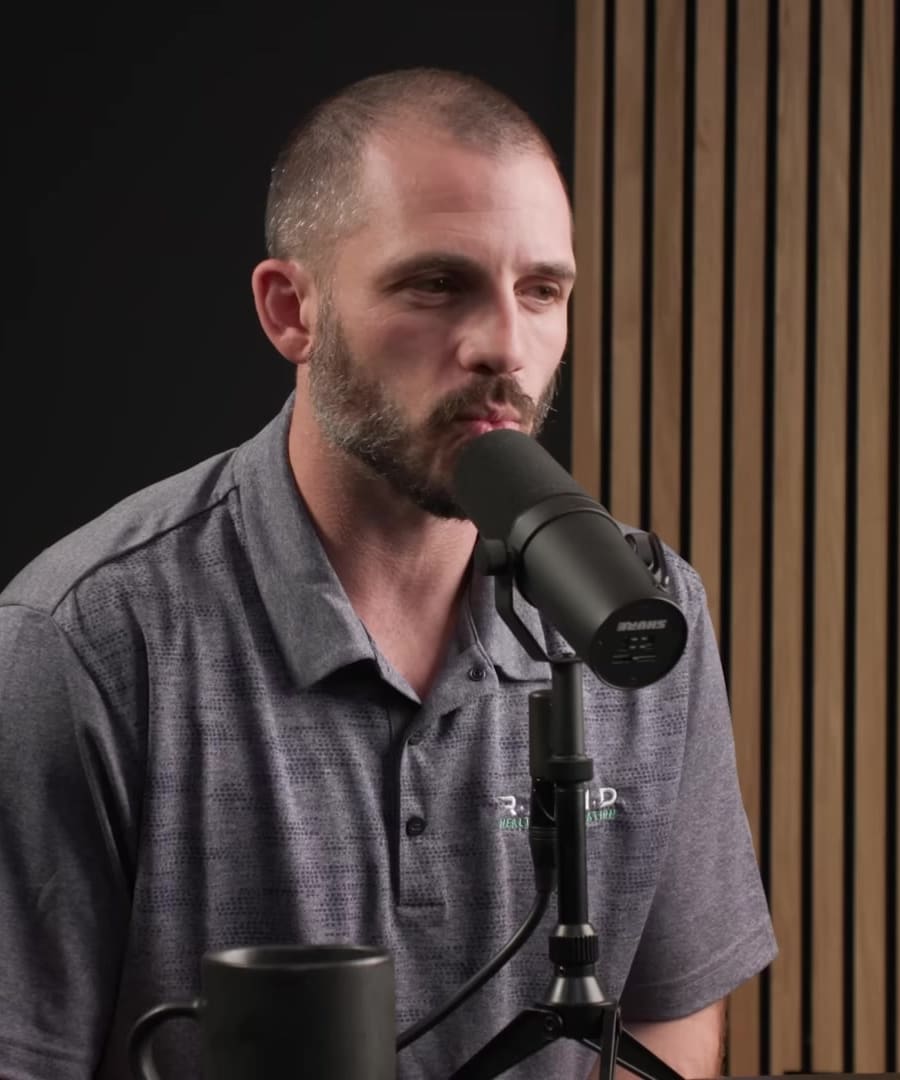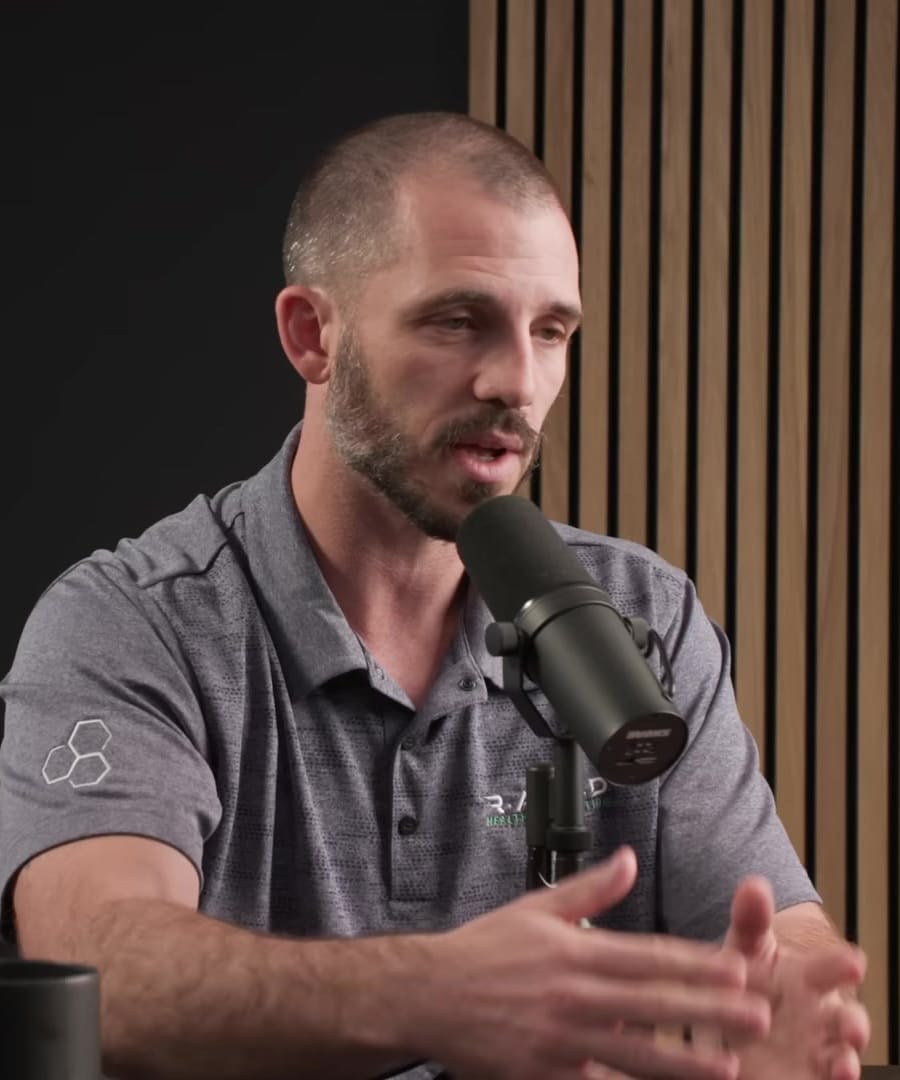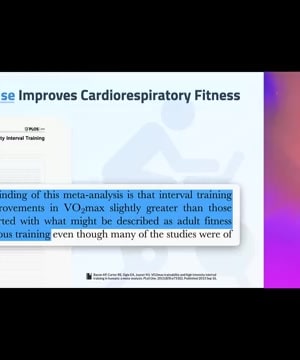What does Andy Galpin says about HRV and Cardio Recovery?
Sources:
provides detailed insights into heart rate variability (HRV) and cardiovascular recovery across various discussions.
-
HRV as a Biomarker: Galpin explains that HRV measures the variation in time between heartbeats and is a strong indicator of one's sympathetic and parasympathetic balance. A high HRV indicates a more relaxed and recovered state, while a low HRV suggests stress and a less recovered autonomic nervous system. He cautions against relying heavily on HRV scores from different devices, as they may measure HRV differently and may not be directly comparable 1 2.
-
Cardio Recovery: Galpin emphasizes the importance of heart rate recovery as a fitness metric. For example, a well-conditioned person should be able to bring their heart rate down to 80% of the max (e.g., from 200 to 160 beats per minute) within two minutes post-exercise. Faster recovery rates indicate better cardiovascular fitness 3.
-
Measuring Recovery: For those tracking recovery, Galpin recommends using a combination of subjective and objective measures, such as mood and HRV or resting heart rate. This approach helps in gaining a comprehensive view of recovery status without becoming overwhelmed by data 4.
These points all highlight the nuanced relationship between HRV, cardiovascular fitness, and recovery, emphasizing the importance of thoughtful and varied measurement strategies.
RELATED QUESTIONS-
Can you tell me more about HRV?
Sources:
Heart rate variability (HRV) measures the variation in time between consecutive heartbeats and serves as an indicator of the autonomic nervous system's function, particularly the balance between the sympathetic and parasympathetic systems. Here's an overview based on expert explanations:
-
Definition and Importance:
- HRV reflects the adaptability of the autonomic nervous system. High HRV indicates a balanced and flexible nervous system, capable of effectively responding to stress and recovery needs, while low HRV suggests a stressed or over-taxed system 1 2.
- It signifies how well the body can maintain homeostasis and adapt to varying physiological demands, indicating overall health and fitness 3.
-
Sympathetic vs. Parasympathetic Activity:
-
Why High HRV is Beneficial:
-
Factors Affecting HRV:
- Positive Influences: Regular exercise, stress management techniques like meditation and deep breathing, adequate sleep, and proper hydration and nutrition can all positively impact HRV 6 2.
- Negative Influences: Dehydration, poor diet, excessive alcohol consumption, intense physical exertion, and high psychological stress levels can lower HRV. Interpersonal stress, such as an argument, can also significantly impact HRV 5.
-
Monitoring and Applications:
- HRV is used in various fields from sports to medicine. Athletes monitor it to optimize training and recovery, while it’s also utilized in settings like lie detection and predicting cardiac events in medical patients 5.
- Tools like the Oura Ring, WHOOP Strap, and other wearable technologies continuously measure HRV to provide insights into sleep quality, recovery, and overall health 1 7.
In essence, HRV is a valuable metric for assessing the balance and adaptability of the autonomic nervous system, offering actionable insights into one's health, fitness, and resilience.
RELATED QUESTIONS-
How to improve HRV?
Sources:
Improving heart rate variability (HRV) involves a combination of lifestyle changes and specific practices that promote a healthy balance between the sympathetic and parasympathetic nervous systems. Here are several expert-recommended strategies to enhance HRV:
Practices to Improve HRV
-
Regular Exercise:
-
Consistent Sleep Patterns:
-
Mindfulness and Relaxation Techniques:
-
Breathing Techniques:
-
Biofeedback:
- Heart rate variability biofeedback involves using devices that provide real-time data on HRV, helping users learn how to control their heart rate through breathing and relaxation exercises. This training can lead to lasting improvements in HRV 3.
-
Avoiding Alcohol and Late-Night Habits:
- Alcohol consumption and irregular sleep patterns can adversely affect HRV. Reducing alcohol intake and maintaining a consistent bedtime can support better HRV 7.
Example Sleep and Supplement Strategy
- Louisa Nicola's Routine:
- Consistent sleep schedule: In bed by 9:30 PM and asleep by 10:00 PM, waking up at 6:00 AM.
- Supplements to support sleep quality: Magnesium Threonate, GABA, and Glycine help ensure better sleep stages like deep and REM sleep, which positively impact HRV 4.
By incorporating these strategies into your daily routine, you can effectively improve your HRV, helping enhance both physical and mental resilience.
RELATED QUESTIONS-
Explain more about cardio recovery
Cardiovascular recovery refers to the process and mechanisms through which the heart and circulatory system recuperate after physical exertion. It encompasses how efficiently the heart rate returns to baseline levels and how well the body manages stress and strain post-exercise.
Key Factors in Cardiovascular Recovery
-
Heart Rate Recovery:
- This is the rate at which the heart slows down post-exercise. A faster decline in heart rate indicates better cardiovascular fitness and autonomic nervous system balance. Good heart rate recovery is linked to higher HRV, a marker of cardiovascular health 1.
-
Inflammation and Repair:
- Exercise induces micro-damage to muscle tissues and increases inflammatory markers. Effective recovery mechanisms include reducing inflammation and repairing tissues, supported by adequate rest and nutrition. Anti-inflammatory foods and supplements like omega-3 fatty acids and antioxidants can play a role 2.
-
Autonomic Nervous System (ANS) Balance:
- The ANS plays a crucial role in cardiovascular recovery through its sympathetic (fight or flight) and parasympathetic (rest and digest) branches. Effective recovery requires a shift from sympathetic dominance during exercise to parasympathetic dominance afterward. Practices like deep breathing and mindfulness aid in activating the parasympathetic system 3 4.
-
Sleep:
- Quality sleep is vital for cardiovascular recovery. During sleep, particularly during deep and REM stages, the body undergoes repair processes and hormonal regulation that are essential for recovery. Consistent sleep schedules and sleep hygiene practices enhance recovery 5.
-
Nutrition and Hydration:
- Proper nutrition, including balanced intake of proteins, carbohydrates, and fats, supports tissue repair and energy replenishment. Staying well-hydrated helps maintain blood volume and supports cardiovascular function 2.
By focusing on these elements, you can improve your cardiovascular recovery, thus promoting better workout effectiveness, overall heart health, and physical resilience.
RELATED QUESTIONS-
What are practical tips for improving cardio recovery?
Sources:
Improving cardiovascular recovery involves several practical strategies, focusing on both physiological and behavioral aspects. Here are some tips shared by experts:
Diet and Hydration
- Nutrition: Emphasize a balanced intake of macronutrients and anti-inflammatory foods. This includes proteins for muscle repair, healthy fats (e.g., omega-3 fatty acids), and carbohydrates for energy replenishment.
- Hydration: Keep hydrated to maintain blood volume and support overall cardiovascular function. Proper hydration aids in the efficient transport of nutrients and removal of waste products 1.
Supplements
- Ensure that you are taking the right supplements in appropriate doses, as incorrect supplementation can be detrimental. Common supplements used to aid recovery include those rich in antioxidants and anti-inflammatory properties 1.
Mindfulness and Breath Work
- Engage in mindfulness practices such as meditation and breath work. These practices help activate the parasympathetic nervous system, promoting relaxation and faster recovery. Controlled breathing, where you take full breaths in a relaxed state, and exhale completely, can be particularly effective 1 2.
Sleep Consistency
- Maintain a consistent sleep schedule. Going to bed and waking up at the same times daily helps regulate your body's internal clock, making your recovery processes more efficient 1.
Physical Positioning
- Adopt positions that facilitate faster heart rate recovery. Lying down with closed eyes helps reduce heart rate more quickly than standing. Once comfortable with lying down, you can progress to seated and then standing positions. This gradual shift can train your body for more effective recovery in various scenarios 2.
Incorporating these tips into your routine can significantly enhance your cardiovascular recovery, allowing for better performance and overall health.
RELATED QUESTIONSWhat are the key factors in cardiovascular recovery?
Sources:
Key factors in cardiovascular recovery, discussed by experts, center on several crucial physiological and lifestyle aspects:
Physiological Factors
- Blood Pressure and Cholesterol: Regular exercise helps reduce blood pressure and improves cholesterol levels, contributing to better cardiovascular health.
- Endothelial Function: Exercise enhances the function of the endothelium, the inner lining of blood vessels, promoting better vasodilation and reducing the risk of clot formation.
- Vagal Tone: Increased vagal tone, which controls heart rate and blood vessel dilation, protects against arrhythmias and heart attacks.
- Larger Coronary Arteries: Vigorous exercise can lead to larger coronary arteries, reducing the risk of blockages and heart attacks even when some blockage is present 1.
Lifestyle Factors
- Time: Allowing sufficient time for recovery is essential. Although time alone is a significant factor, many people don't have the luxury to wait, making additional strategies important 2.
- Sleep: Adequate sleep is paramount for recovery. It helps repair cardiovascular tissues and maintains overall health.
- Nutrition and Hydration: Proper nutrition and staying well-hydrated support cardiovascular function and aid in the recovery process.
- Stress Management: Effectively managing stress can improve heart health and enhance overall recovery. Stress reduction strategies like mindfulness and meditation can be beneficial 2.
- Psychological Well-being: Regular physical activity has profound antidepressant effects and can make individuals feel more in control, aiding in better overall recovery 1.
Incorporating these factors can significantly enhance cardiovascular recovery and overall well-being.
RELATED QUESTIONSWhat kinds of exercise are best for cardiovascular recovery?
Sources:
For cardiovascular recovery, experts highlight several effective types of exercise:
Low-Intensity Cardio
- Walking: Sal Di Stefano emphasizes walking as highly beneficial for most people due to its safety and effectiveness in promoting cardiovascular health. Regular walking, such as 15 minutes after each meal, can significantly enhance overall health without the injury risks associated with running 1 2.
High-Intensity Interval Training (HIIT)
- Short Bursts: Adam Schafer recommends HIIT for improving cardiovascular fitness, involving short bursts of high-intensity exercise followed by recovery periods. This can include activities like sprints, elliptical sessions, or treadmill work with varied rest intervals 1.
Work Capacity Exercises
- Loaded Carries: Justin Andrews suggests exercises focusing on work capacity, such as farmer carries, which involve carrying weights over a distance. These exercises increase heart rate steadily and engage the whole body, aiding cardiovascular endurance and overall fitness 1.
Low-Intensity Steady-State Cardio
- Light Cardio: For recuperation and regeneration, Sal Di Stefano advises low-intensity steady-state (LISS) cardio, such as treadmill walking at a moderate pace. This facilitates recovery by promoting blood flow, oxygen, and nutrient delivery to muscles, aiding faster recovery without the high stress of intense workouts 3.
Saunas as an Exercise Mimic
- Post-Exercise Sauna: Rhonda Patrick mentions that sauna use after exercise can enhance cardiovascular recovery. Combining exercise with sauna sessions improves cardiorespiratory fitness, blood pressure, and lipid profiles more effectively than exercise alone 4.
These varied approaches provide options suitable for different fitness levels and recovery needs, ensuring comprehensive cardiovascular recovery and health enhancement.
RELATED QUESTIONSWhat are the important measurements according to Dr Andy Galpin?
Sources:
Dr. Andy Galpin emphasizes several important measurements for fitness, recovery, and overall health:
VO2 Max
- Significance: VO2 Max is a key indicator of cardiovascular and aerobic fitness, representing the volume of oxygen consumed and used during intense exercise. It's closely linked to overall physical ability and general health, making it a strong predictor of mortality 1.
Strength
- Grip Strength: This can be measured using a hand grip dynamometer, which is affordable and provides crucial data on overall strength. Ideal grip strength values are around 40 kg for males and 35 kg for females, with ideal ranges being higher 2.
Recovery
- Subjective and Objective Metrics: He suggests measuring one subjective metric (e.g., mood) and one objective metric (e.g., HRV, resting heart rate) for daily monitoring. More comprehensive assessments can be done quarterly or semiannually 3.
Athletic Ability
- Jump Tests: Dr. Galpin recommends measuring the distance of a standing jump and the height difference between standing reach and a two-handed vertical jump for assessing athletic ability. These tests are simple and cost-effective 4.
Longevity Predictors
- Metabolic Testing: VO2 Max can also be estimated using simpler tests like a two-minute step test or a mile-and-a-half run. These methods are easily accessible and provide reasonably accurate estimates without the need for expensive equipment 5.
These measurements help in tailoring fitness programs and monitoring progress, ultimately enhancing health and performance.
RELATED QUESTIONSWhat impacts VO2 Max?
Sources:
VO2 Max, a key indicator of cardiovascular fitness, is influenced by several physiological factors:
Cardiac Output
- Primary Determinant: The maximum rate of blood and oxygen pumped by the heart per minute is a crucial factor. Elite athletes exhibit higher maximal cardiac outputs (e.g., 40 liters per minute) compared to untrained individuals (15-20 liters per minute) 1 2.
Muscle Oxygen Utilization
- Muscle Efficiency: The ability of muscles to extract and utilize oxygen also affects VO2 Max. Both cardiac output and muscle mitochondrial adaptations play significant roles 1 3 4.
Training and Adaptation
- High-Intensity Training: High-intensity interval training (HIIT) has been shown to be effective in improving cardiac output and VO2 Max by enhancing stroke volume and overall cardiovascular efficiency 1 2.
- Consistency: Regular cardiovascular exercise, such as moderate-intensity training, also contributes to improvements in VO2 Max, especially in less athletic populations 5 6.
Holistic Health Factors
- Mitochondrial Health: Overall mitochondrial efficiency, influenced by diet, sleep, and regular exercise, impacts VO2 Max. Sleep quality and nutrition are critical for maintaining optimal mitochondrial function and, consequently, VO2 Max 3.
Genetic Components
- Genetic Factors: While there is a significant variable element that can be improved through training, genetics also play a role in determining the baseline and potential improvements of VO2 Max 2.
Comprehensive Influence
- Overall Health Marker: VO2 Max is a comprehensive marker that reflects the health of the cardiovascular, respiratory, and muscular systems. It's strongly correlated with overall physical ability and mortality, making it a critical measurement for assessing fitness and longevity 7 1.
These factors together outline the multi-faceted nature of VO2 Max and the various approaches to improving and understanding it.
RELATED QUESTIONSWhat genetic factors affect VO2 Max?
Sources:
Genetic factors significantly impact VO2 Max, forming a baseline on which training adaptations build. discusses how genetic predisposition plays a role in an individual's ceiling for VO2 Max improvements. Essentially, while anyone can enhance their VO2 Max with proper training, the extent of improvement can be limited by genetic factors 1 2.
Key genetic factors affecting VO2 Max include:
Muscle Fiber Composition
- Type I and Type II Fibers: Genetic makeup determines the proportion of slow-twitch (Type I) and fast-twitch (Type II) muscle fibers. Type I fibers are more efficient at using oxygen, enhancing endurance capabilities and thus, VO2 Max.
Mitochondrial Function
- Efficiency and Quantity: The efficiency and quantity of mitochondria in muscle cells, often influenced by genetics, affect how well muscles utilize oxygen during exercise. Superior mitochondrial function supports higher VO2 Max.
Cardiovascular Genetics
- Heart Size and Function: Genetic factors influence heart size and pump efficiency, affecting the volume of blood (and thus oxygen) that can be delivered to muscles during high-intensity exercise.
Hormonal Regulation
- Erythropoietin (EPO): Genes influencing the production of EPO, a hormone that regulates red blood cell production, play a crucial role. Higher red blood cell counts improve oxygen transport capacity.
While training can significantly enhance these factors, genetic predisposition sets the foundation for VO2 Max potential 1 3.
RELATED QUESTIONSHow can I improve my VO2 Max?
Sources:
Improving VO2 Max involves both aerobic and anaerobic strategies, focusing on consistent and varied intensity workouts. Here are some key methods discussed by experts:
High-Intensity Interval Training (HIIT)
- Vigorous Intensity: Engage in short bursts of very vigorous exercise at least at 80% max heart rate, followed by rest periods. Known to significantly enhance VO2 Max, especially where moderate intensity doesn't yield results.
- Norwegian 4x4 Protocol: This involves four minutes of high-intensity exercise followed by three minutes of low-intensity recovery, repeated four times. It's recognized as a particularly effective protocol 1 2.
Cardiovascular Exercises
- Continuous Exercise: Activities like running, swimming, or cycling for 20-60 minutes at a moderate intensity (70-85% of max heart rate) are effective. Consistently challenging your heart with sustained efforts helps improve overall cardiovascular fitness 3 4.
Capillary and Mitochondrial Adaptations
- Increase Capillary Density: More capillaries enhance oxygen diffusion into muscles, improving VO2 Max. This is achieved through consistent aerobic training, which develops the vascular network within muscles.
- Boost Mitochondrial Function: Mitochondria are crucial for aerobic metabolism. Training that promotes mitochondrial biogenesis, such as endurance exercises, can increase their efficiency and number 3.
Interval Training Varieties
- 1-Minute Intervals: Short, intense bursts of exercise (1 minute) followed by recovery can also improve VO2 Max. This approach is suitable for those looking for efficient workouts 2.
Holistic Approach
- Diet, Sleep, and Lifestyle: Optimal VO2 Max isn't just about exercise; it integrates overall health practices including good nutrition, adequate sleep, and a stress-free lifestyle. Consistent healthy habits create the foundation for effective VO2 Max improvement 5.
Consistency and progression are key. Gradually increase the intensity and volume of your workouts, listening to your body to prevent overtraining. Incorporate both continuous and interval training to maximize adaptations.
RELATED QUESTIONS



























